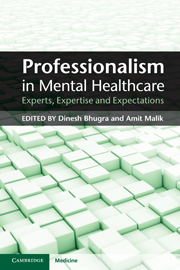Book contents
- Professionalism in Mental Healthcare
- Professionalism in Mental Healthcare
- Copyright page
- Contents
- Contributors
- Preface
- Chapter 1 Introduction
- Chapter 2 Globalization
- Chapter 3 The virtues and vices of professionalism
- Chapter 4 Professionalism
- Chapter 5 Professionalism
- 6 Professionalism and resource-poor settings
- Chapter 7 Professionalism
- Chapter 8 Can professionalism be taught? Lessons for undergraduate medical education
- Chapter 9 Patient expectations from psychiatrists
- Chapter 10 Teams and professionalism
- Chapter 11 New professionalism
- 12 Medical professionalism in the new century
- Chapter 13 Ethical foundations of professionalism
- Chapter 14 Training in professionalism
- Chapter 15 Expertise and medical professionalism
- Chapter 16 Leadership and professionalism
- Chapter 17 Professionalism and psychiatry
- Index
Chapter 8 - Can professionalism be taught? Lessons for undergraduate medical education
Published online by Cambridge University Press: 10 November 2010
- Professionalism in Mental Healthcare
- Professionalism in Mental Healthcare
- Copyright page
- Contents
- Contributors
- Preface
- Chapter 1 Introduction
- Chapter 2 Globalization
- Chapter 3 The virtues and vices of professionalism
- Chapter 4 Professionalism
- Chapter 5 Professionalism
- 6 Professionalism and resource-poor settings
- Chapter 7 Professionalism
- Chapter 8 Can professionalism be taught? Lessons for undergraduate medical education
- Chapter 9 Patient expectations from psychiatrists
- Chapter 10 Teams and professionalism
- Chapter 11 New professionalism
- 12 Medical professionalism in the new century
- Chapter 13 Ethical foundations of professionalism
- Chapter 14 Training in professionalism
- Chapter 15 Expertise and medical professionalism
- Chapter 16 Leadership and professionalism
- Chapter 17 Professionalism and psychiatry
- Index
Summary
- Type
- Chapter
- Information
- Professionalism in Mental HealthcareExperts, Expertise and Expectations, pp. 82 - 91Publisher: Cambridge University PressPrint publication year: 2010



